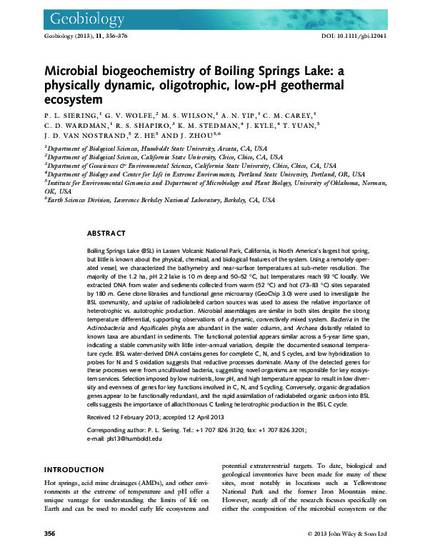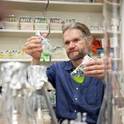
- Biogeochemistry,
- Hot springs,
- Geothermal resources,
- Geothermal ecology,
- Marine geophysics
Boiling Springs Lake (BSL) in Lassen Volcanic National Park, California, is North America's largest hot spring, but little is known about the physical, chemical, and biological features of the system. Using a remotely operated vessel, we characterized the bathymetry and near-surface temperatures at sub-meter resolution. The majority of the 1.2 ha, pH 2.2 lake is 10 m deep and 50-52 [degrees]C, but temperatures reach 93 [degrees]C locally. We extracted DNA from water and sediments collected from warm (52 [degrees]C) and hot (73-83 [degrees]C) sites separated by 180 m. Gene clone libraries and functional gene microarray (GeoChip 3.0) were used to investigate the BSL community, and uptake of radiolabeled carbon sources was used to assess the relative importance of heterotrophic vs. autotrophic production. Microbial assemblages are similar in both sites despite the strong temperature differential, supporting observations of a dynamic, convectively mixed system. Bacteria in the Actinobacteria and Aquificales phyla are abundant in the water column, and Archaea distantly related to known taxa are abundant in sediments. The functional potential appears similar across a 5-year time span, indicating a stable community with little inter-annual variation, despite the documented seasonal temperature cycle. BSL water-derived DNA contains genes for complete C, N, and S cycles, and low hybridization to probes for N and S oxidation suggests that reductive processes dominate. Many of the detected genes for these processes were from uncultivated bacteria, suggesting novel organisms are responsible for key ecosystem services. Selection imposed by low nutrients, low pH, and high temperature appear to result in low diversity and evenness of genes for key functions involved in C, N, and S cycling. Conversely, organic degradation genes appear to be functionally redundant, and the rapid assimilation of radiolabeled organic carbon into BSL cells suggests the importance of allochthonous C fueling heterotrophic production in the BSL C cycle.

This work was authored as part of the Contributor's official duties as an Employee of the United States Government and is therefore a work of the United States Government. In accordance with 17 U.S.C. 105, no copyright protection is available for such works under U.S. Law. This is the publisher’s final pdf. Originally published online by Wiley.